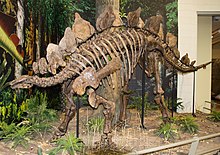Portal:Dinosaurs
IntroductionDinosaurs are a diverse group of reptiles of the clade Dinosauria. They first appeared during the Triassic period, between 243 and 233.23 million years ago (mya), although the exact origin and timing of the evolution of dinosaurs is a subject of active research. They became the dominant terrestrial vertebrates after the Triassic–Jurassic extinction event 201.3 mya and their dominance continued throughout the Jurassic and Cretaceous periods. The fossil record shows that birds are feathered dinosaurs, having evolved from earlier theropods during the Late Jurassic epoch, and are the only dinosaur lineage known to have survived the Cretaceous–Paleogene extinction event approximately 66 mya. Dinosaurs can therefore be divided into avian dinosaurs—birds—and the extinct non-avian dinosaurs, which are all dinosaurs other than birds. Dinosaurs are varied from taxonomic, morphological and ecological standpoints. Birds, at over 11,000 living species, are among the most diverse groups of vertebrates. Using fossil evidence, paleontologists have identified over 900 distinct genera and more than 1,000 different species of non-avian dinosaurs. Dinosaurs are represented on every continent by both extant species (birds) and fossil remains. Through the first half of the 20th century, before birds were recognized as dinosaurs, most of the scientific community believed dinosaurs to have been sluggish and cold-blooded. Most research conducted since the 1970s, however, has indicated that dinosaurs were active animals with elevated metabolisms and numerous adaptations for social interaction. Some were herbivorous, others carnivorous. Evidence suggests that all dinosaurs were egg-laying, and that nest-building was a trait shared by many dinosaurs, both avian and non-avian. (Full article...) Selected articleTarbosaurus (meaning 'terrifying lizard') is a genus of tyrannosaurid theropod dinosaur that flourished in Asia between 70 and 65 million years ago, near the end of the Late Cretaceous Period. Fossils have been recovered in Mongolia with more fragmentary remains found further afield in parts of China. Although many species have been named, modern paleontologists recognize only one, T bataar, as valid. Some experts contend that this species is actually an Asian representative of the North American genus Tyrannosaurus; if true, this would invalidate the genus Tarbosaurus altogether. Tarbosaurus and Tyrannosaurus are considered closely related genera, even if they are not synonymous. Alioramus, also from Mongolia, is thought by some authorities to be the closest relative of Tarbosaurus. Like most known tyrannosaurids, Tarbosaurus was a large bipedal predator, weighing more than a ton and equipped with dozens of large, sharp teeth. It had a unique locking mechanism in its lower jaw and the smallest forelimbs relative to body size of all tyrannosaurids, renowned for their disproportionately tiny, two-fingered forelimbs. Tarbosaurus lived in a humid floodplain criss-crossed by river channels. In this environment, it was an apex predator at the top of the food chain, probably preying on other large dinosaurs like the hadrosaur Saurolophus or the sauropod Nemegtosaurus. Tarbosaurus is very well-represented in the fossil record, known from dozens of specimens, including several complete skulls and skeletons. These remains have allowed scientific studies focusing on its phylogeny, skull mechanics, and brain structure. (see more...) TopicsSubcategoriesSelected image
Photo credit: User:NobuTamura Did you know...
Things you can do
Featured article candidates
Peer reviews
Articles to be merged
Articles to be split
Related content
Associated WikimediaThe following Wikimedia Foundation sister projects provide more on this subject:
Discover Wikipedia using portals |





























